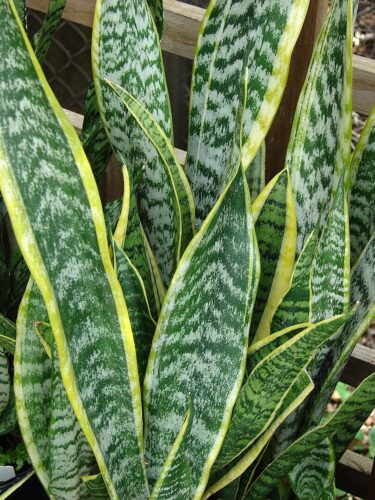Sansevieria is a cactus-like plant in the aspa
Also known as:
Snake Plant
Mother-in-law’s tongue
Devil’s tongue
Bow string hemp
You are viewing the mobile-adapted version of the page.
The one for tablets, laptop and desktop also provides general information, such as origin, toxicity and cultivation.
Sansevieria (Dracaena trifasciata) is a cactus-like plant in the aspa
Sansevierias are strong houseplants that are not very susceptible to pests and diseases.
At night, the long leaves absorb CO2 from the air, making them suitable for bedrooms. Because the leaves are poisonous when ingested, a spot in a child’s room is undesirable.
Location: bright spot, but not in direct sunlight. In darker areas, the variegated colors become softer.
Soil: potting soil for cacti, or peat-free regular potting soil mixed with some sharp sand.
Repotting: Sansevierias grow slowly, repotting is only necessary once every two or three years. Choose a pot that is at least 20% larger.
Watering: In moderation! Better to have too little water than too much. In winter, a little water once a month is sufficient. Rest of the year: only water only when the soil is dry; avoid leaving water in the ornamental pot.
Care: Give sansevierias some ‘Cactus & Succulent’ or ‘Houseplant’ labelled concentrate fertiliser once a month from March through September. Then immediately wipe off the leaves dust with a damp cloth. A sansevieria cannot be pruned.
Cuttings: Multiply sansevierias by dividing them. Using a knife, carefully cut away a leaf with a piece of root from the plant and plant it in a small pot with some potting soil mixed with sharp sand. Water and place the new plant in a bright spot, but not in direct sunlight.
Bugs
Keep an eye out for mealybugs, spider mites, scale, thrips, whitefly & root mealybugs. Remove these with a damp cloth.
Fungi & diseases
Leaves show brown leaf margins or brown spots: root rot.
Care
Leaves turn yellow: too much water (especially in winter). If the leaves show wrinkles, the plant has too little water.
Leaves fall over: too much or too little water and sometimes old leaves also fall over just because of age.

